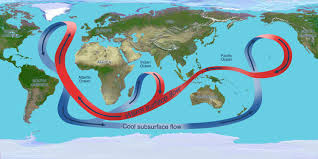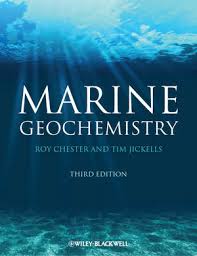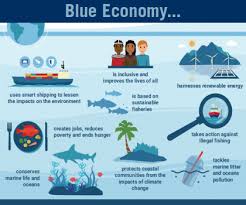Ocean Circulation: A Vital Driver of Earth’s Climate and Ecosystems 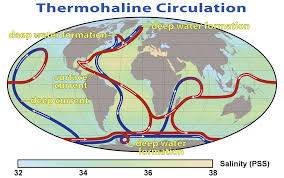
The large-scale movement of seawater caused by factors like wind, temperature gradients, salinity variations, and the Earth’s rotation is referred to as ocean circulation. Because they affect weather patterns, nutrient distribution, heat transmission, and the global migration of biological creatures, these water motions are essential to the operation of the Earth’s climate system. In addition to climate science, managing marine resources, forecasting extreme weather, and preserving marine biodiversity all depend on an understanding of ocean circulation.
Heat is distributed around the earth primarily via ocean currents, and circulation mechanisms affect everything from small marine ecosystems to global weather systems. This article examines the various forms of ocean circulation, its mechanisms, their function in controlling the planet’s climate, and
- What is Ocean Circulation?The constant flow of seawater around the world is known as ocean circulation, and it is mostly caused by wind, temperature and salinity variations, and the rotation of the Earth. The ocean, which makes up around 71% of the planet’s surface, is essential to maintaining life and controlling global temperatures.
There are many different scales at which ocean circulation takes place, from tiny currents along the shore to enormous global circulation systems that cover whole ocean basins. Heat transfer from the equator to the poles, nutrient cycle, and the control of atmospheric gases like carbon dioxide and oxygen all depend on the flow of ocean water.
The following are the main categories of ocean circulation:
wind patterns, which are the main source of surface currents.
Due to variations in water density, deep-water currents were produced.
- The Forces Driving Ocean Circulation
Ocean circulation is driven by a combination of factors, each of which plays a different role in shaping water movement. These include:
2.1 Wind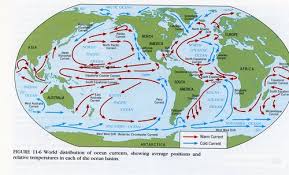
Winds are the main force behind surface currents. Ocean surface waters are pushed by winds, resulting in currents that flow in predictable ways. The main forces behind ocean circulation at the surface are the westerlies, which blow from west to east in temperate zones, and the trade winds, which blow from east to west in tropical regions.
The hemisphere and distance from the equator determine which way these wind-driven currents flow. Moving water is deflected to the left in the Southern Hemisphere and to the right in the Northern Hemisphere by the Coriolis effect, which is brought on by the Earth’s rotation. The round, clockwise current flow in the Northern Hemisphere and the counterclockwise flow in the Southern Hemisphere are caused by this phenomena.
Another important idea is the Ekman spiral.
2.2 Temperature and Salinity Gradients (Thermohaline Circulation)
Deeper ocean currents are driven by variations in water density, which are influenced by salinity and temperature, whereas surface currents are driven by wind. The large-scale movement of seawater caused by these temperature and salinity variations is referred to as thermohaline circulation, or the global conveyor belt.
Temperature: Cold water tends to sink because it is denser than warm water. Water sinks to the ocean floor near the poles because it cools and gets denser there. We refer to this process as deep water formation.
Salinity: The density of saltwater is also influenced by its salinity, or the amount of salt present. Particularly in regions with significant rates of evaporation, like the Mediterranean Sea, more saline water is denser and has a tendency to sink.
2.3 The Coriolis Effect
The Coriolis effect is a result of Earth’s rotation. As water moves, the Coriolis effect causes it to deflect to the right in the Northern Hemisphere and to the left in the Southern Hemisphere. This creates the characteristic gyres — large, circular currents in the ocean basins. The Coriolis effect plays a critical role in shaping the direction and speed of ocean currents.
- Northern Hemisphere: Water flows in a clockwise direction in large oceanic gyres, with currents moving along the eastern edges of the continents and flowing back toward the west along the western edges.
- Southern Hemisphere: Gyres flow counterclockwise due to the Coriolis deflection.
2.4 Tidal Forces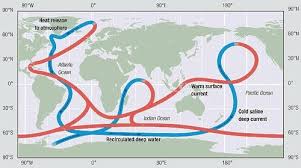
The moon’s and, to a lesser extent, the sun’s gravitational pull is what causes tides. The interplay between the Earth, moon, and sun causes tidal currents that alter the movement of ocean waters, particularly in coastal areas. As the tides rise and fall, water flows into and out of bays, estuaries, and coastal areas in tidal currents, which are usually short-term.
In shallow coastal locations, tides affect the vertical movement of water, which can have an impact on nutrient distribution and mixing processes. Despite being less powerful than thermohaline and wind-driven currents, tidal forces nevertheless have a role in the general flow of water, particularly around coastlines.
- Major Ocean Currents and Circulation Patterns
The Earth’s oceans are divided into five major basins: the Pacific, Atlantic, Indian, Southern (Antarctic), and Arctic Oceans. Within these basins, ocean currents and circulation patterns take on a variety of forms, each playing a role in climate regulation, nutrient cycling, and marine ecosystems.
3.1 The Atlantic Meridional Overturning Circulation (AMOC)
One of the essential elements of thermohaline circulation is the AMOC. Warm water from the tropics is transported to the North Atlantic by it, where it cools, sinks, and travels deeply south. By moving heat from the equator to higher latitudes, particularly Western Europe, this process significantly influences the global climate. Because of its function in transporting water globally, the AMOC is frequently referred to as the “global conveyor belt.”
Gulf Stream: A powerful ocean current in the Atlantic, the Gulf Stream carries warm water northward along the U.S. East Coast from the Gulf of Mexico, ultimately adding to the AMOC. Western Europe’s climate is significantly milder than that of other areas at comparable latitudes thanks to the Gulf Stream.
3.2 The Pacific Ocean Circulation
In the Pacific, ocean circulation is influenced by both wind and thermohaline gradients. The North Pacific Gyre and South Pacific Gyre are two large, circular currents that circulate in opposite directions, influenced by the Coriolis effect.
- El Niño and La Niña: The El Niño-Southern Oscillation (ENSO)phenomenon, which occurs in the tropical Pacific, significantly impacts ocean circulation. During El Niño events, the trade winds weaken or reverse, causing warm water to accumulate in the central and eastern Pacific. This disrupts normal ocean circulation patterns and leads to a variety of climate impacts worldwide, including droughts, floods, and altered weather patterns.
- Kuroshio Current: The Kuroshio Currentis a powerful warm current in the western Pacific, which has a significant impact on the climate of East Asia and the North Pacific region. It carries warm water northward along the coast of Japan, affecting the region’s weather and marine life.
3.3 The Indian Ocean Circulation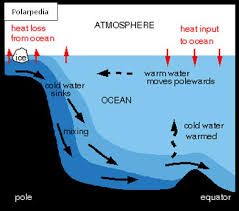
The Indian Ocean has a unique circulation pattern due to the monsoon winds that reverse seasonally. The Indian Ocean Gyre circulates counterclockwise, influenced by the trade winds during the summer months and the westerlies during the winter months.
- Monsoon Circulation: The seasonally reversing winds affect both surface and deep ocean currents, and this seasonal shift plays a critical role in nutrient distribution and marine productivity, particularly in the Arabian Sea and Bay of Bengal.
- The Importance of Ocean Circulation
Ocean circulation is central to many processes that regulate Earth’s climate and support life. Some of the most important roles of ocean circulation include:
4.1 Climate Regulation
Ocean currents are critical in regulating the Earth’s climate by redistributing heat around the globe. For instance, the Gulf Stream in the North Atlantic Ocean carries warm water from the tropics to Europe, contributing to the relatively mild winters in Western Europe. In contrast, the cold currents in the Southern Ocean help cool the polar regions.
4.2 Nutrient Distribution
Ocean circulation plays an essential role in nutrient cycling. Upwelling zones, where deep water rises to the surface, bring nutrients to the photic zone (the sunlit upper layer of the ocean), supporting primary production by phytoplankton. This process forms the base of the marine food web and supports marine ecosystems.
4.3 Marine Ecosystems and Biodiversity
Marine species depend on ocean currents for migration, reproduction, and the availability of food. For example, many fish species migrate across vast distances, using ocean currents to guide their movements. Coral reefs, which are located in relatively stable water conditions, rely on ocean currents for the transport of larvae and nutrients.
- Climate Change and Ocean Circulation
Ocean circulation is being impacted by climate change in a number of ways. Ocean currents, especially the Atlantic Meridional Overturning Circulation (AMOC), are becoming less stable and stronger as a result of rising global temperatures. Seawater’s density and salinity are decreased as polar ice melts and freshwater enters the ocean, which may interfere with deep-water formation and impede the AMOC.
Global climate systems, marine habitats, and weather patterns may all be significantly impacted by changes in ocean circulation. The possible slowing of thermohaline circulation may cause the tropics to warm and the North Atlantic to cool, changing global weather patterns and resulting in more intense weather events and modified monsoon systems.
- Conclusion
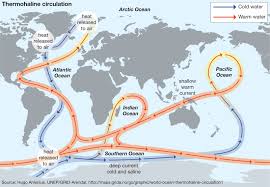
Because it distributes heat, controls weather, and sustains marine life, ocean circulation is an essential part of the Earth’s climate system. The movement of water in the oceans, from surface currents driven by wind to deep-water flows influenced by salinity and temperature variations, is a major factor in forming the planet’s environment. Predicting future climate change, managing marine resources, and preserving the health of the seas all depend on an understanding of these intricate processes. A healthy and functional ocean circulation system will be crucial for the welfare of marine life and human society as long as human activities continue to have an impact on the oceans.

